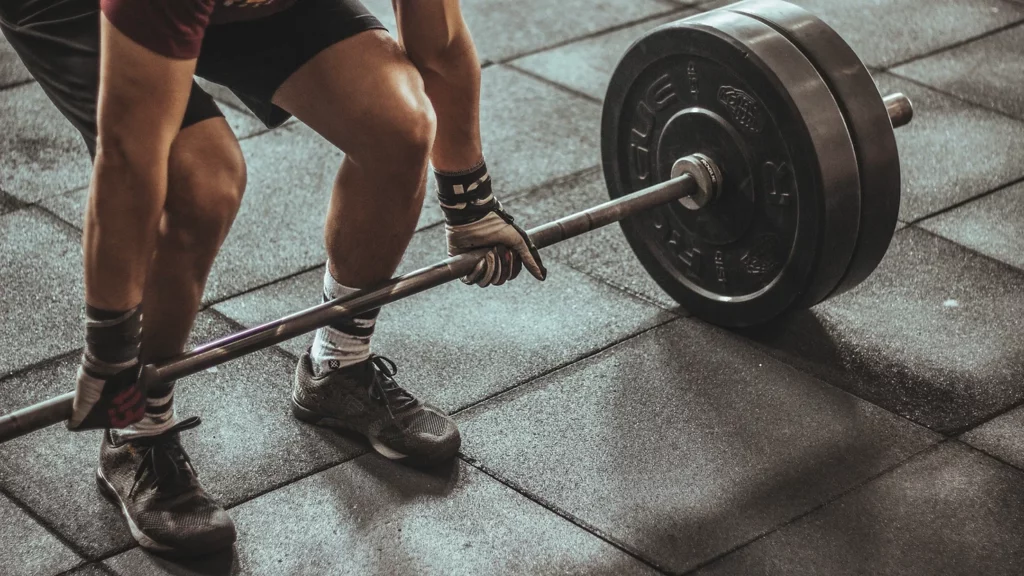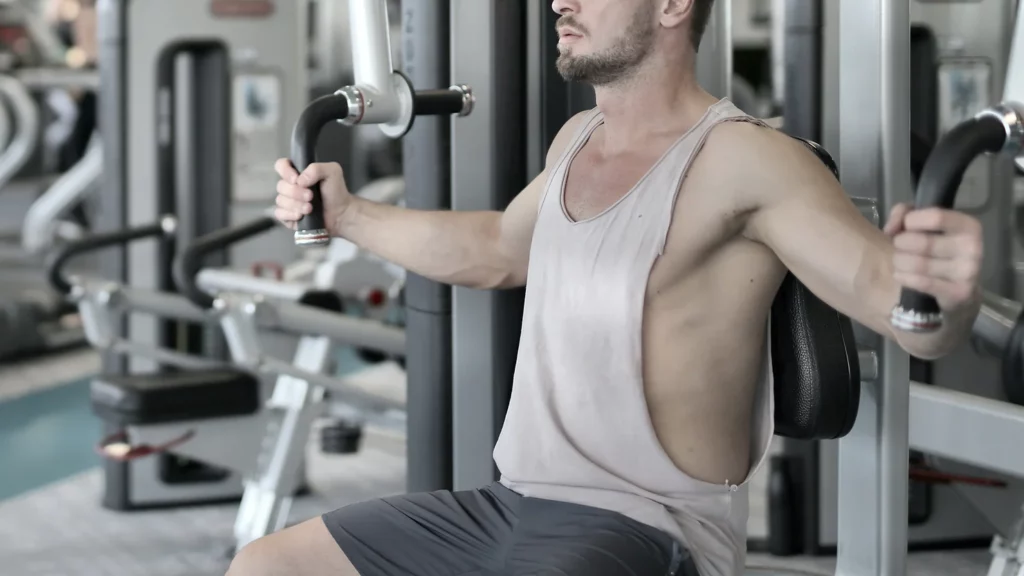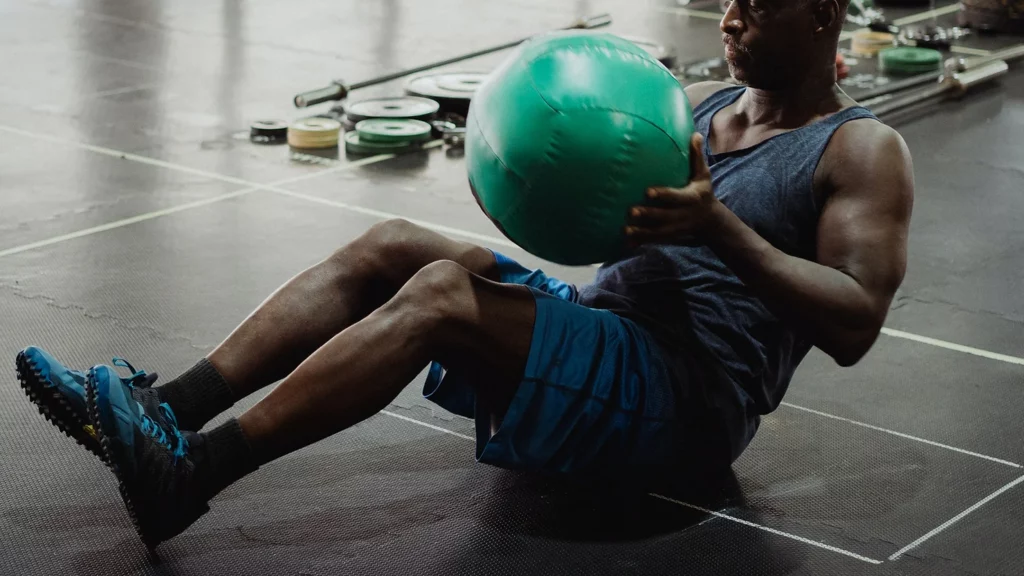What muscles does the deadlift work?
The deadlift is an excellent exercise for anyone looking to build muscle and strength. The primary muscles targeted are the hamstrings, glutes, and back. However, the deadlift also recruits the quads, shoulders, and trapezius muscles.
The advantages of this exercise over other forms of strength training are that it works several muscle groups in one motion and is a compound activity. This means that it uses multiple joints, which results in more muscle growth. In addition, the deadlift is considered a functional exercise, meaning that it trains muscles to work together in order to perform everyday activities.
The deadlift is essential for those looking to build a strong and muscular physique. It is also beneficial for those wanting to improve their strength and power.
How to perform the deadlift?
The most common way to perform the deadlift is the conventional deadlift. To perform this version, start with your feet hip-width apart and the barbell in front of you. Bend at your hips and knees to grip the barbell with an overhand grip, keeping your arms straight.
From here, lift the barbell by extending your hips and knees until you are standing upright. At the top of the movement, squeeze your glutes and lock your hips in place. Reverse the motion to return the barbell to the ground.
Certain cues to be aware of when performing this movement are to keep your back straight, your chin tucked, and your shoulders down and back. It is also important to engage your lats (latissimus dorsi) by trying to pull the barbell into your hips.
Common Mistakes
When performed correctly, the deadlift is a safe exercise. However, there are some common mistakes that people make which can lead to injuries. These include rounding the back, using too much weight, and not engaging the core muscles.
It is important to keep the back straight and avoid rounding it during the deadlift. This can put unnecessary stress on the spine and lead to injuries. The core muscles should be engaged throughout the movement to provide stability and support for the spine. Additionally, using too much weight can also lead to injuries. It is important to use a weight that you can control and is within your abilities.
Variations of the Deadlift
Variation #1: Sumo Deadlift
The sumo deadlift is a variation of the conventional deadlift that targets the same muscle groups with emphasis on the inner thighs, glutes, and hamstrings. The main difference is in the stance and grip. For the sumo deadlift, start with your feet wider than hip-width apart and your hands inside shoulder-width.
From here, bend at your hips to lower your torso until it is nearly parallel to the ground. From this position, extend your hips to lift the barbell off the ground and return to standing. Reverse the motion to return the barbell to the ground.
Cues to remember for this exercise are to keep your chest up, back straight, and head up. It is also important to keep the barbell close to your body throughout the movement.
Variation #2: Trap Bar Deadlift
The trap bar deadlift is another variation of the conventional deadlift. It is a great exercise for beginners as it is easier to learn and execute than the conventional deadlift. The main difference is in the bar that is used. For the trap bar deadlift, a hexagonal bar is used. This allows for a more neutral grip which puts less stress on the wrists and elbows.
To perform the trap bar deadlift, start with the bar in the center of your feet. Bend at your hips and knees to grip the bar. From here, extend your hips and knees to lift the barbell off the ground. At the top of the movement, squeeze your glutes and lock your hips in place. Reverse the motion to return the barbell to the ground.
Cues to remember for this exercise are to keep your back straight, your chin tucked, and your shoulders down and back. It is also important to engage your lats (latissimus dorsi) by trying to pull the barbell into your hips.
Variation #3: Romanian Deadlift
The Romanian deadlift is a variation of the conventional deadlift that targets the hamstrings, glutes, and back. The main difference is in the range of motion. For the Romanian deadlift, start with the barbell at hip level. From here, bend at your hips to lower your torso until it is nearly parallel to the ground.
From this position, extend your hips to lift the barbell off the ground and return to standing. Reverse the motion to return the barbell to the ground.
Cues to remember for this exercise are to keep your chest up, back straight, and head up. It is also important to keep the barbell close to your body throughout the movement.
Variation #4: Dumbbell Deadlift
The dumbbell deadlift is a variation of the conventional deadlift that can be done with either one dumbbell or two. This exercise targets the same muscle groups as the conventional deadlift with the main difference being in the weight that is used.
To perform the dumbbell deadlift, start with the dumbbell(s) on the ground in front of you. Bend at your hips and knees to pick up the dumbbell(s). From here, extend your hips and knees to lift the dumbbell(s) off the ground. At the top of the movement, squeeze your glutes and lock your hips in place. Reverse the motion to return the dumbbell(s) to the ground.
Cues to remember for this exercise are to keep your back straight, your chin tucked, and your shoulders down and back. It is also important to engage your lats (latissimus dorsi) by trying to pull the dumbbell(s) into your hips.
Variation #5: Single-Leg Deadlift
The single-leg deadlift is a variation of the conventional deadlift that targets the same muscle groups. The main difference is in the balance that is required. This exercise can be done with either one dumbbell or two.
To perform the single-leg deadlift, start with the weight on the ground in front of you. Bend at your hips and knees to pick up the weight. From here, extend your hips and raise one leg behind you. From this position, lower the weight down towards the ground. Reverse the motion to return to standing.
Cues to remember for this exercise are to keep your back straight, your chin tucked, and your shoulders down and back. It is also important to engage your lats (latissimus dorsi) by trying to pull the weight into your hips.
Variation #6: Kettlebell Deadlift
The kettlebell deadlift is a variation of the conventional deadlift that targets the same muscle groups. The main difference is in the weight that is used. For this exercise, a kettlebell is used instead of a barbell.
To perform the kettlebell deadlift, start with the kettlebell on the ground in front of you. Bend at your hips and knees to pick up the kettlebell. From here, extend your hips and knees to lift the kettlebell off the ground. At the top of the movement, squeeze your glutes and lock your hips in place. Reverse the motion to return the kettlebell to the ground.
Cues to remember for this exercise are to keep your back straight, your chin tucked, and your shoulders down and back. It is also important to engage your lats (latissimus dorsi) by trying to pull the kettlebell into your hips.
Variation #7: Snatch-Grip Deadlift
The snatch-grip deadlift is a variation of the conventional deadlift that targets the same muscle groups. The main difference is in the grip that is used. For this exercise, a wider grip is used in order to target the muscles of the back more.
To perform the snatch-grip deadlift, start with the barbell on the ground in front of you. Bend at your hips and knees to pick up the barbell. From here, extend your hips and knees to lift the barbell off the ground. At the top of the movement, squeeze your glutes and lock your hips in place. Reverse the motion to return the barbell to the ground.
Cues to remember for this exercise are to keep your back straight, your chin tucked, and your shoulders down and back. It is also important to engage your lats (latissimus dorsi) by trying to pull the barbell into your hips.
Variation #8: Deficit Deadlift
The deficit deadlift is a variation of the conventional deadlift that targets the same muscle groups. The main difference is in the range of motion that is used. For this exercise, the lifter starts in a position with their feet on an elevated surface. This allows for a greater range of motion, which targets the muscles of the legs more.
To perform the deficit deadlift, start with the barbell on the ground in front of you. Place your feet on an elevated surface so that you are in a position with a greater range of motion. Bend at your hips and knees to pick up the barbell. From here, extend your hips and knees to lift the barbell off the ground. At the top of the movement, squeeze your glutes and lock your hips in place. Reverse the motion to return the barbell to the ground.
Cues to remember for this exercise are to keep your back straight, your chin tucked, and your shoulders down and back. It is also important to engage your lats (latissimus dorsi) by trying to pull the barbell into your hips.
Variation #9: Rack Pull
The rack pull is a variation of the deadlift that targets the same muscle groups. The main difference is in the starting position of the exercise. For this exercise, the barbell is already on the rack at waist level.
To perform the rack pull, start with the barbell in the rack at waist level. Bend at your hips and knees to pick up the barbell. From here, extend your hips and knees to lift the barbell off the ground. At the top of the movement, squeeze your glutes and lock your hips in place. Reverse the motion to return the barbell to the ground.
Cues to remember for this exercise are to keep your back straight, your chin tucked, and your shoulders down and back. It is also important to engage your lats (latissimus dorsi) by trying to pull the barbell into your hips.
Variation #10: Single-Leg Romanian Deadlift
The single-leg Romanian deadlift is a variation of the Romanian deadlift that targets the same muscle groups. The main difference is in the number of legs that are used. For this exercise, only one leg is used to perform the exercise.
To perform the single-leg Romanian deadlift, start with the barbell in front of you. Bend at your hips and knees to pick up the barbell. From here, extend your hips and knees to lift the barbell off the ground. At the top of the movement, squeeze your glutes and lock your hips in place. Reverse the motion to return the barbell to the ground.
Cues to remember for this exercise are to keep your back straight, your chin tucked, and your shoulders down and back. It is also important to engage your lats (latissimus dorsi) by trying to pull the barbell into your hips.
When performing this exercise, it is important to keep a slight bend in the knee of the working leg. This will help to ensure that the exercise is targeting the muscles of the leg and not the knee joint.
Summary
The deadlift is a great exercise for building muscle and strength. It can be performed with a variety of different variations to target different muscle groups. When performing the deadlift, it is important to keep good form by keeping your back straight, your chin tucked, and your shoulders down and back. Remember to engage your lats by trying to pull the barbell into your hips. Common mistakes people make when performing the deadlift are to round their back, not keep their chin tucked, and to let their shoulders shrug up. These can all lead to injuries. When performed correctly, the deadlift is a great exercise for building muscle and strength.
Are you looking to get fit? Look no further! Our fitness programs are designed to help you build a strong and aesthetic physique. We also provide easy-to-follow routines that will fit any schedule. With our fitness programs, you'll have the tools you need to build muscle and achieve your fitness goals. Click the link below to get started!



